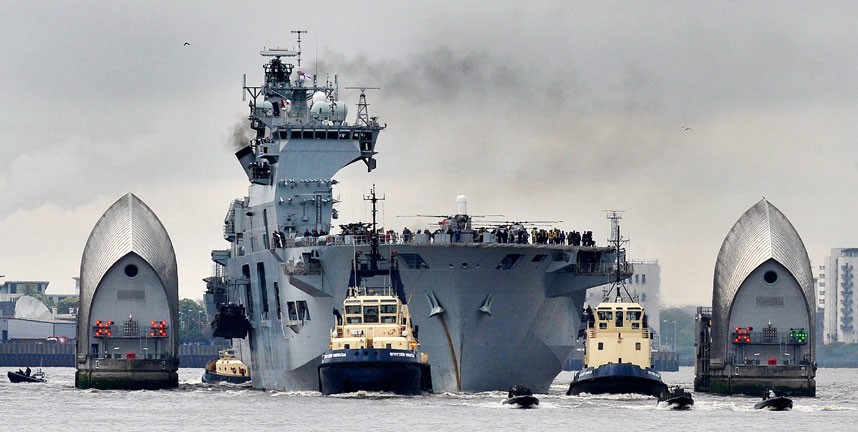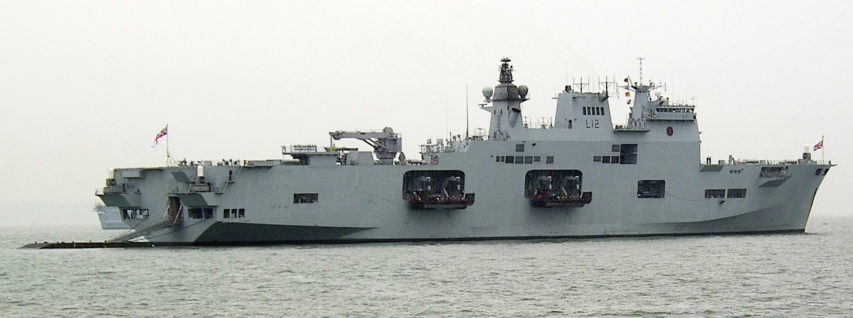In The Register, Gareth Corfield sums up reports on the disposition of the Royal Navy’s current flagship after a 20-year service life:

HMS Ocean at the Thames Barrier in 2012, being moved into position to support the Olympic Games in London.
The 22,000-tonne helicopter carrier, which returned from her last British deployment to the Caribbean just weeks ago, will be formally decommissioned from the RN in spring this year.
Although it was well known that Ocean was up for sale and that Brazil (as well as Turkey) were interested in buying the 20-year-old warship, confirmation of the deal and the purchase price were all “known unknowns” until now.
The news was broken by defence blog UK Defence Journal, citing a Brazilian journalist.
The Brazilian Navy’s end-of-year roundup statement, published on Christmas Eve 2017, also included the line: “Minister Raul Jungmann and the Brazilian Navy Commander Eduardo Bacellar Leal Ferreira took the opportunity to announce the purchase of the Royal Navy’s HMS Ocean multifunction vessel, valued at £84m sterling.”
A British Ministry of Defence spokesman told El Reg: “Discussions with Brazil over the long-planned sale of HMS Ocean are at an advanced stage, but no final decisions have been made. HMS Ocean has served admirably with us since 1998 and the revenue she generates will be reinvested in defence as we bolster our Royal Navy with two types of brand new frigates and two huge aircraft carriers.”

HMS Ocean at the 2005 International Fleet Review, showing Landing Craft on davits and Stern Ramp deployed.
Photo via Wikimedia.
At the Thin Pinstriped Line, Sir Humphrey explains why selling the ship now makes sense for the Royal Navy:
The big change to this requirement came in 2015, when the SDSR [Strategic Defence and Security Review]confirmed that the RN would keep both carriers in active service, and that neither would be CTOL [conventional take-off and landing]. Suddenly the RN found itself planning for a future where it would have two CVF available [the Queen Elizabeth class carriers], both of which would need to have manpower available to crew them. It also meant that the RN could make modifications to the ships to ensure that either of them could operate as an LPH [Landing Platform Helicopter] and carry helicopters and troops as well as a fixed wing airgroup.
This decision has had major ramifications for Ocean – suddenly the need for her to remain in service was gone. The LPH role that she would have done would now be filled by two newer and vastly more capable ships – the UK wasn’t losing capability but gaining it. In practical terms the RN actually would have more chance of an LPH being available without Ocean as CVF availability will be higher, both can role as an LPH (rather than CTOL which would not do this task) and with both platforms active, there is far less chance of the nightmare situation of both the CTOL carrier and the old LPH being stuck in refit at the same time.
From a capability perspective, the move to CVF makes a lot of sense. There are issues to be resolved (arguably the littoral manoeuvre capability offered by her landing craft, the vehicle issue and the question of what to do about afloat 1&2* command platforms and where to put them), but Ocean paying off is not going to remove the LPH capability from the UK toolkit.
The second problem has been that even if the RN wanted to run Ocean on, it has run out of manpower to do so. This year will see Queen Elizabeth at sea doing complex trials, drawing heavily on the Fleet Air Arm personnel to do so. As Prince of Wales (POW) stands up, more and more crew (usually very specialised engineers and the like) will be needed to bring her out of build. On the old plan this wouldn’t have been an issue – one would have gone straight into reserve. Now, the RN has to bring both carriers into service at roughly the same time (a helpful reminder of RN capability here is that it is the only navy in the world currently introducing two supercarriers into service at roughly the same time).
Ocean requires a lot of specialist crew who will be needed on QE and POW, and more importantly so will their reliefs. The manpower planners have not been working on the assumption of three carriers available and at sea (something the RN arguably has not done consistently for many years), and so the manpower structure is not designed to provide this. It could be changed, but would need many years to produce the right numbers of people in the right slots to deliver it without breaking manpower and causing retention challenges.





